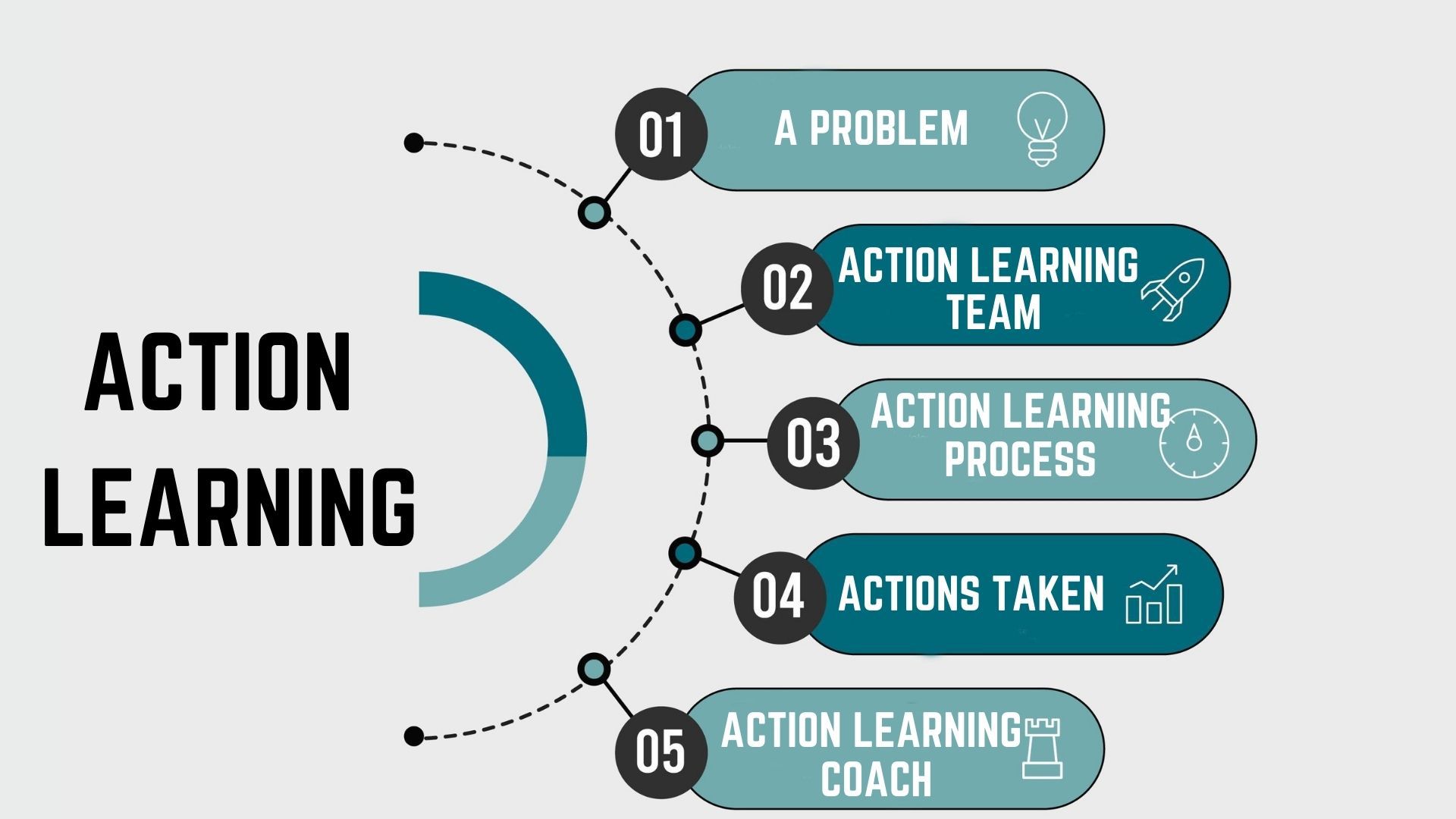
What are the Key Components of Action Learning?

Action learning is a dynamic problem-solving approach that helps individuals and organizations find innovative solutions to complex challenges It involves a team working collaboratively to identify and address a specific problem, under the guidance of an experienced coach Through this process, participants develop their skills, knowledge, and confidence, while delivering tangible results for their organization
Action learning involves developing innovative solutions to overcome challenging problems encountered by organizations, individuals, or groups. This approach entails taking measurable actions to address the issue at hand and examining each step's efficacy to derive valuable insights.
What is action learning?
Action learning is a technique that involves learning from one's own actions. This method involves a systematic approach to addressing issues faced by both individuals and organizations. Each step taken during the process is carefully evaluated to ensure its effectiveness. The purpose of this evaluation is to develop an innovative and efficient solution to the problem, which can then be implemented.
The action learning process offers a pragmatic approach to problem-solving, with each step being carefully evaluated to determine its effectiveness. This results in only the most effective steps being considered for the overall process, making it a highly effective method for team learning and problem-solving. As such, many organizations choose to adopt action learning as a means of developing both their employees and the organization as a whole.
The action learning process differs from an action learning project. While the latter involves assigning a learning project to a team and asking them to put their newfound knowledge into action, the former entails identifying a problem, assembling a group of peers or an individual, and taking a step-by-step approach to solving the problem while reflecting on each step involved in the learning process.
Action learning was introduced by Professor Reginald Revans, who believed that creating a small group of individuals with diverse knowledge and experiences to tackle a problem was an effective method for problem-solving and learning. He successfully implemented the action learning process in management development and the revival of numerous organizations.
How does action learning work?
Action learning is a powerful approach to resolving organizational issues by tapping into the unique skills and leadership abilities of individuals. This method focuses on personal development by empowering employees to voice their ideas and provide solutions to the challenges faced by the organization. In an action learning environment, all team members are treated equally and have the same opportunity to contribute to the problem-solving process.
The action learning process involves selecting a group of employees, known as the "set," who are tasked with discussing and identifying solutions to the problem at hand. The first step for the set is to select a group leader or facilitator who will play a crucial role in ensuring the set functions effectively. The facilitator's responsibilities include performing specific tasks to ensure the set operates efficiently.
The facilitator is responsible for making all the preparation to conduct a meeting.
He/she will play the role of an advisor for the other members of the group.
Structuring the meeting time in a way to get maximum work done.
Instructing and controlling the members’ participation to avoid altercations and wastage of time.
Craft questions that enable the acquisition of accurate and relevant information. Foster an environment of inclusivity and fairness that affords all individuals the opportunity to engage in discourse and express their opinions without bias or prejudice.
Making the list of solutions proposed by members of the set and follow up with them later.
To perform the role of an intermediary between the organization’s management and the group members.
To encourage the members to develop creative and innovative ideas and think out of the box.
To develop a final solution and present the final solution to the organization’s management.
In the context of improvised action learning, it is recognized that the facilitator's involvement can potentially stifle the creative thinking process of the group members. As a result, the group leader's role is primarily focused on organizing and leading group discussions. This includes tasks such as scheduling meeting times, offering ideas to address the problem at hand, fostering a positive and productive group dynamic, actively listening to the contributions of others, and ultimately implementing the agreed-upon solution.
Once the group has arrived at a final solution, they may present it to other employees within the organization and seek assistance if necessary. Any modifications or adjustments made based on feedback from external parties are then discussed during the subsequent action learning meeting.
During a meeting, the main objective is to review and discuss the contributions made by members outside of the set, and to evaluate the progress made based on the lessons learned from previous meetings. The facilitator will inquire about the actions taken by members, the results achieved, and any challenges encountered during the implementation process. Additionally, the facilitator will encourage members to share their insights and learnings gained from their experiences in order to improve the overall effectiveness of the set.
During the four stages of action learning, the group collaborates to identify a solution for a problem. In the first stage, members provide input and feedback, which is then used to inform the actions taken. The final step involves gathering feedback on the implemented solution and making necessary improvisations based on the insights gained through the action learning process.
Components of the action learning program
In a well-designed action learning program, a small group of individuals work together to solve a problem related to the organization's employees. This process not only addresses the issue at hand, but it also prioritizes learning and improvement for the members involved. To ensure success, an action learning program must incorporate several essential components, which we will explore in detail.
1. A problem
The cornerstone of action learning is the identification of a problem. This problem can take various forms such as a work project, a challenge faced by the organization, an issue concerning an employee, a problem with the employee's behavior within the organization, an opportunity, or a task. The problem serves as the starting point for the learning process, driving the team towards finding solutions and improving performance.
During the action learning process, a problem is identified as the starting point. However, it is crucial that the problem at hand has significant impact on the organization's overall performance to warrant the use of action learning. Smaller issues are typically resolved with the intervention of a manager.
Throughout the problem-solving process, action learning members view the problem as a chance for personal growth and development. The knowledge gained from the process can be utilized for individual improvement or to equip employees with organizational skills to prevent future similar problems. The end result of action learning is a valuable set of skills and knowledge that can benefit both the individual and the organization.
An employee's inappropriate behavior towards colleagues can create a toxic work environment. However, implementing an action learning process can help address the issue by providing a warning and assisting the employee in changing their behavior. The knowledge gained from the process can also be shared with other employees to prevent similar behavior from occurring in the future.
2. An action learning team or group
The action learning team, which is the second main component of the action learning process, is comprised of a group of individuals who are also known as the action learning group. This group typically consists of four to eight people who may have been selected based on their expertise and problem-solving abilities or have volunteered to participate in the process.
The action learning process involves the selection of group members from various levels within different organizations. This diversity of perspectives allows for a comprehensive analysis of the problem at hand. Each member is responsible for providing their individual opinion on the issue and working together to generate a viable solution.
3. Action learning process
During the action learning process, the third component involves a series of steps designed to gain profound insights into the situation at hand. Members of the group employ strategic questioning techniques to gather comprehensive information about the problem, leaving no detail unexplored. Through this process, they gain a clear understanding of the problem's explicit nature and effectively communicate it to other group members.
If the team members know the exact nature of the problem only, they can think clearly to find the problem’s solution.
4. Actions are taken
The action learning process is only effective when the necessary steps are taken to solve the problem at hand. The ultimate goal is to reach a point where actionable solutions are determined. It's crucial that group members have the freedom to decide which actions to take and then implement them, as actions are key to determining the success of the process. By implementing actions, any shortcomings in decisions can be identified, leading to informed next steps.
Thus, action learning can be done by reflecting on the problem, preparing strategies to solve the problem, and then finally implementing the actions to solve it.
5. Action learning coach
The role of an action learning coach is crucial in guiding and supporting the members of the team. As a leader, the coach facilitates the process of problem-solving by encouraging reflective thinking and exploring different solutions. Through a series of questions, the coach helps the group members to gain a deeper understanding of the issue at hand.
In turn, the group members collaborate to develop a plan of action and work towards finding a suitable solution. The coach provides constructive feedback on their progress and organizes regular meetings to ensure that the team is on track. The coach's guidance and support are essential in ensuring the success of the action learning process.
:
The action learning coach serves as a liaison between the organization's management, group members, and employees. They communicate the progress of the action learning group to management and gather feedback to share with the group.
The action learning approach is a proactive initiative taken by organizations to address and resolve employee behavioral issues. Its primary objective is to identify and implement effective solutions that can be applied in similar situations in the future. The process involves first alerting the employee about the problematic behavior and then concluding with either implementing a solution or taking necessary disciplinary action, including termination if required.













